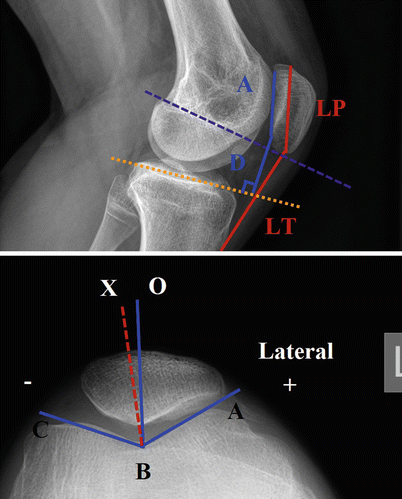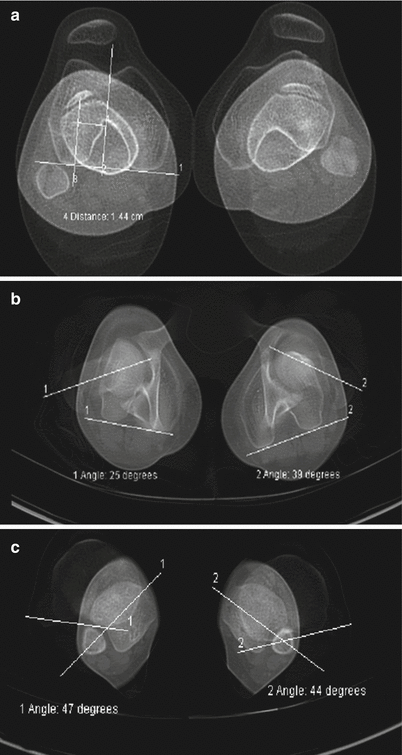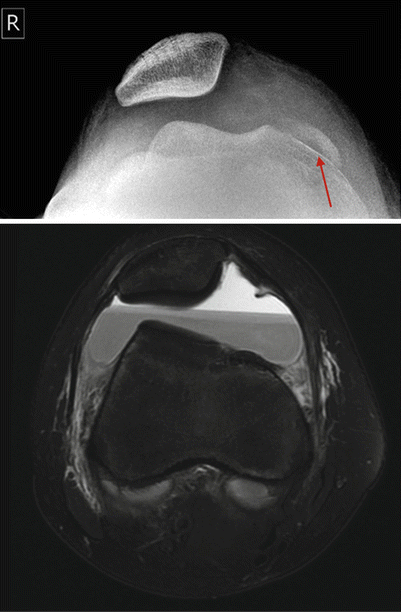Fig. 12.1
Dejour classification of trochlear dysplasia. The Dejour classification: Grade A (54 %), Trochlear morphology is preserved but fairly shallow; Grade B (17 %), Flat or convex trochlea; Grade C (9 %), Asymmetry of trochlear facets: lateral facet is convex and medial facet is hypoplastic and Grade D (11 %), Asymmetry of trochlear facets, vertical joint (cliff pattern)

Fig. 12.2
Radiological indices around the knee. Top radiograph (knee lateral) shows the Blumensaat’s line (blue dashed) touches the lower border of the patella. Insall-Salvati index: Ratio, or index, of patella tendon length (LT) to patella length (LP) should be 1.0. An index of 1.2 is alta and 0.8 is baja. Blackburne-Peel index: Ratio of the distance from the tibial plateau to the inferior articular surface of the patella (D) to the length of the articular surface of the patella (A) should be 0.8. An index of 1.0 is alta
Bottom radiograph shows the sulcus angle ABC, line BO is the bisector and line BX passes through the lowest point of the patella. Angle OXB is the congruence angle of Merchant. A patella-femoral sulcus angle (ABC) > 144° is abnormal. Congruence angle of Merchant (OBX normally −6°–−8°). Abnormal if it is more than +16°. Positive (+) means Lateral) while (−) means medial.

Fig. 12.3
CT scan of the lower limbs assessing the TGTT distance (a), femoral torsion (b) and tibial torsion (c)

Fig. 12.4
Patellar dislocation with OCD fragment
In the literature for adult studies Kohlitz et al. [12] retrospectively assessed MRI imaging of 186 acute lateral patella dislocations and 186 age and sex matched controls and identified that the incidence of trochlea dysplasia in the dislocation group was 66 %, of these 36 % additionally had patella alta and 9 % an abnormal TT-TG, with only 15 % of dislocators having no anatomical risk factors. They inferred a 37-fold increased risk of dislocation for individuals with trochlea dysplasia and abnormal TT-TG and a 41-fold higher risk if trochlea dysplasia and patella alta were present – whilst suggesting most dislocators have anatomical risk factors this study does not investigate risk of recurrence. Steenson [13] compared MRI imaging of 60 knees with and 120 knees without recurrent patellar instability and found the recurrent dislocation group had a higher incidence of trochlear dysplasia (68.3 % vs. 5.8 %), patella alta (60.0 % vs. 20.8 %), increased TT-TG distance (42.0 % vs. 3.2 %) and rotational deformity (26.7 % vs. 2.5 %). Furthermore, multiple anatomic risk factors were identified in 58.3 % of patients with recurrent dislocation compared to only 1.7 % of controls.
In summary whilst there has clearly been an association demonstrated between these radiological anatomical indices and recurrent patella dislocation the strength of evidence available in the literature is limited with only level 3 evidence available to support them as reliable predictors of recurrence. Further studies are required to convincingly demonstrate a causative relationship. Available data suggests they can be used help to guide treatment choice and tailor surgical plan to address abnormal anatomy, and the presence of multiple abnormal anatomical indices does suggest an increased risk of recurrence.
What’s the Best Treatment for Acute First Time Dislocation?
Currently there is no unanimously accepted stratagem for the treatment of first time patella dislocation, either in the paediatric or adult settings with both conservative and surgical management being popular, in no small part due to the lack of convincing evidence for favouring either approach with several papers giving conflicting evidence and outcomes. The Cochrane review [14] analysed five randomised studies and one quasi-randomised study with a total of 344 patients with first time patella dislocation. Four of the studies included paediatric patients. There was consistent evidence that the surgical intervention group had a significantly lower risk of recurrent dislocation following first time dislocation at 2–5 years follow-up with a relative risk of 0.53 favouring surgery. Given a demonstrative risk of recurrent dislocation in 222 people per 1000 in the non-surgical group, the data equates to 104 fewer people per 1000 having recurrent dislocation after surgical management. Furthermore there was (weaker) evidence of a lower risk of recurrent dislocation after surgery at 6–9 years with 110 fewer patients per 1000 having recurrent dislocation after surgery. However the authors of the review explained that although there was evidence in favour of surgical management in the short term the quality of the evidence was very low as the studies had a high risk of bias due to a lack of blinding and issues with selection and subsequently concluded that ‘the evidence is not of sufficient quality to confirm a significant difference in outcome between surgical or non-surgical initial management’ for first time acute patella dislocation. It is also difficult to generalise this review to the paediatric population as only one of the studies has a paediatric only subgroup [15] and this is specifically acknowledged in the review.
The Nikku [15] study (included in the Cochrane review) child only cohort has subsequently been published as a separate paper by Palmu [16]. This is the only randomised trial in the paediatric literature which compares conservative and surgical treatment in acute patella dislocation. In this study patients under 16 presenting with acute patella dislocation were randomised to conservative management (28 knees) or surgical intervention (36 knees). Patients were followed up for a mean of 14 years with a 94 % follow up rate. The rate of recurrent dislocation was high in both groups (71 % vs 67 %) despite this subjective outcome reporting was favourable with 75 % of conservatively treated patients and 66 % of surgically treated patients reporting a good or excellent outcome at the final follow up – suggesting disconnection between recurrence and patient reported outcomes. There was no significant difference identified between the two groups in subjective reporting, functional assessment or re – dislocation rate at either the 6 year or 14 year follow up points and the authors concluded that surgery does not improve long term outcome and therefore is not advocated for acute patellar dislocation in children and adolescents.
As the Palmu study is the only randomised trial in the paediatric literature there have understandably been no systematic reviews of conservative vs surgical treatment in acute patella dislocation undertaken, however in the adult literature four have been published since 2011 [17], [18] − updated to [19–21]. Mirroring the broader literature on the topic the results are at odds with each other, a recent met-analysis of these papers [22] attempted to assess which of these meta-analyses provides the current best available evidence. They used the Oxman-Guyattn and Quality of Reporting of Meta-analyses systems to assess the quality of the reviews and applied the Jadad algorithm to determine which offered the highest level of evidence. The four studies included 1984 patients with 997 undergoing surgery and the 987 being treated with conservative management. Three studies found that surgically treated patients had a lower re-dislocation rate whereas the other found no difference between the groups. None of the studies found a difference in functional outcome scores between the two treatment groups. The Jadad algorithm determined that the Hing and the Zheng papers offered the highest level of currently available evidence. From this they concluded that although operative treatment may offer a lower rate of re-dislocation than conservative treatment this does not correlate with functional outcome measures.
The majority of the literature assessing the comparison of operative versus non-operative management excludes patients with significant osteochondral lesions and the presence of these represent an indication for surgical management of first time dislocation. This is broadly accepted throughout the literature and is particularly supported in the paediatric population by a French multi-centre study reporting good outcomes for surgical fixation of osteochondral injuries in patella dislocation [23]. Similarly concomitant severe ligamentous injury represent an indication for surgical management and these situations represent a caveat to the approach for simple patella dislocation.
In conclusion the paediatric literature is sparse regarding evidence base for deciding conservative or operative management for acute first time patella dislocation, the only randomised study advocates a conservative approach. The data available in the adult literature whilst suggesting recurrent dislocation is reduced by operative management does not indicate this improves functional outcome and as yet clinical equipoise remains as to the gold standard approach in simple first time acute patella dislocation. A review of anatomical risk factors should be considered to help guide management decisions.
What Is the Best Conservative Management Strategy?
The evidence base behind conservative management is deficient, particularly for the paediatric population. The broad treatment goals are relief of symptoms, preservation of range of motion, enhancement of quadriceps strength and return to previous activity. Classically a short period of immobilisation is instigated to relieve symptoms, followed by formal physiotherapy. There is no firm evidence in the literature to support immobilisation and studies have shown no difference in outcome when comparing immobilisation to none [24]. There have been no randomised trials into physiotherapy regimes [25] and no consensus has been reached on best rehabilitation schedule. Vastus medialis obliquus (VMO) has been suggested as an important target for strengthening after patella dislocation, however a systematic review has found little evidence to suggest that VMO activity can be preferentially enhanced in comparison to vastus lateralis by physiotherapy [26]. It is broadly accepted in the literature that the aim of the conservative treatment whatever form it takes is to avoid chronic muscle weakness and imbalance.
What Surgical Option Is the Best for Paediatric Patella Dislocation?
A key consideration in the skeletally immature patient is the proximity of the open physes of the distal femur and apophyses of the tibial tubercle to the site of intervention. Procedures in the armamentarium of the adult surgeon are either not recommended (eg tibial tubercle osteotomies) or modified (MPFL reconstruction) to avoid future growth disturbance.
A multitude of surgical procedures have been described for the treatment of paediatric patella dislocation. These can be divided into lateral release procedures, distal alignment procedures, MPFL reconstructions/medial reefing and trochleoplasty procedures, furthermore combinations of the above can be employed.
Lateral Release
This has historically been a first line intervention either in isolation or often combined with medial capsule reefing and other procedures [27–38]. It has been shown in the adult literature that this does not prevent recurrence [39] and improvement in outcome scores are not maintained after more than 4 years when performed in isolation for patella femoral instability [40]. There are no studies in the paediatric literature comparing lateral release with other surgical treatments, only level 4 evidence supporting its use in combination with other procedures.
Distal Realignment Procedures
As discussed previously an increased TT-TG distance has been suggested as a marker of recurrent instability [13] and this explains the rationale for adjusting the alignment of the extensor mechanism. Avoiding growth disturbance by leaving the tibial tubercle apopyhsis intact has formed the basis of the surgical techniques developed in this category. The ‘Grammont (soft rod)’ procedure comprises removing the deep patellar tendon fibres off the cartilaginous tibial tuberosity without severing the distal tendon attachment to periosteum and re-attaching it medially. A study by Garin [32] retrospectively assessed outcome with this procedure in 50 paediatric knees with a recurrent dislocation rate of 16 % and a ‘good’ satisfaction score in over 75 %, however the group is heterogeneous both in terms of degree of instability pre operatively and treatment given (procedure combined with others) and this is grade 4 evidence. Kraus [41] assessed the outcome in 65 paediatric knees – the outcome scores achieved were fair but the re-dislocation rate was high with 8 knees having a single dislocation within 3 months and 3 having recurrent late dislocations. The re-dislocations were associated with trochlea dysplasia suggesting this should also be addressed at the time of surgery.
The Roux-Gouldthwait procedure involves detachment of the lateral half of the patella tendon, guiding it under the intact medial half and reattaching it to the medial epiphysis. Nelitz [34] conducted a level 3 retrospective case controlled study comparing a cohort with unfavourable outcome and recurrent instability (37 children) following this procedure with a cohort with favourable outcome. The incidence of trochlea dysplasia was increased in the study group (89 % vs 21 %) and it was concluded that failure to address this was the likely cause of poor outcome and recurrent instability – supporting a tailored surgical approach addressing all elements of altered anatomy.
There are no studies comparing distal realignment with other procedures. In the adult literature Silanpaa [42] compared MPFL reconstruction (with adductor magnus tenodesis – 18 knees) with Roux-Gouldthwait distal re-alignment (29 knees) and identified a lower dislocation rate (7 % vs 14 %) and higher rate of osteoarthritis in the MPFL reconstruction group – suggesting a superiority for MPFL reconstruction.
MPFL Repair, Reconstruction and Medial Reefing
Biomechanical studies have shown that the MPFL is the major soft tissue restraint to lateral patellar dislocation [43, 44] and it is commonly injured when the patella dislocates [45], this can be identified with MRI [46]. Resultantly the MPFL has become the focus of surgical treatment for primary and recurrent patella dislocation in both paediatric and adult populations.
Repair of the acutely injured MPFL has been reported in the paediatric literature [16] and was found to be no better than conservative treatment. In the adult literature two prospective randomised studies have demonstrated improved patella stability with MPFL repair compared to conservative management [47, 48] however only one demonstrated a significant improvement in subjective outcome [48]. Delayed repair has not been shown to improve stability or outcome [49]. It has been suggested that repair of the MPFL may be insufficient on its own in the paediatric population particularly when anatomic abnormality is present [50].
MPFL reconstruction has become the main stay of surgical treatment for primary and recurrent patella-femoral dislocation in the adult population with numerous studies demonstrating achievement of good stability with few complications [51], however most of these are level 4. Bitar [52] performed a randomised controlled trial with 41 knees with acute patellar dislocation randomised into two groups – MPFL reconstruction and non-operative treatment. The surgical group had a lower recurrence rate (0 % vs 35 %) and a higher (better) Kujala outcome score at 2 years.
In the paediatric literature a myriad of techniques have been described – with the specific aim of avoiding physes. There have been several case series highlighting satisfactory outcomes with MPFL reconstruction [29, 53–57] but as yet there is no higher evidence than level 4 available.
Medial plication has a similar standing to lateral release procedures, having been historically popular and often used in combination with it [27, 29, 30, 32, 34, 37]. The adult literature suggests MPFL reconstruction is superior to medial plication resulting in better static patellar position and functional outcome [58].
Trochleoplasty
The use of trochleoplasty in skeletally immature patients is contentious, Beals [59] reports a case series of 6 knees in paediatric patients who successfully underwent trochleoplasty for patellofemoral instability. There were no re-dislocations and no skeletal growth complications, however it should be noted that these patients all had chromosomal abnormalities with resultant limited motor demands. A prospective study by Utting [60] followed up 59 knees treated with trochleoplasty for at least 1 year and showed a statistically significant improvement in outcome from pre-op scores – with 92.6 % of patients satisfied with the outcome. Smith [61] performed a systematic review of the literature on the procedure including the Beals paper and concluded that trochleoplasty is a safe and effective procedure for patella femoral instability in trochlea dysplasia patients but that the evidence had significant methodological limitations. A further systematic review by Bollier [62] suggested trochleoplasty ‘should be reserved for sever dysplasia in which patellofemoral stability cannot otherwise be obtained’ and advocated a tailored approach to address abnormal anatomy.
In summary it has not been shown which surgical option or combination is the optimum treatment. Emerging evidence suggests that if surgery is indicated then a tailored approach should be adopted to address significant anatomical abnormality.
What Is the Best Treatment for Congenital Dislocation?
Congenital dislocation is a rare entity and this is reflected in the literature with only 2 series addressing its management (Table 12.1). Gordon [36] reported a series of 17 knees with an average age at presentation of 7 years and 9 months. All patients had a fixed unreducible dislocation and all underwent surgery which entailed lateral release, advancement of VMO and in skeletally immature patients medial transfer of the patella tendon, skeletally mature patients had transfer of the tibial tubercle. At follow up all patients had ‘a marked improvement’ in pain and activity tolerance, there was one redislocation. Wada [63] retrospectively reviewed 7 knees in a younger cohort (average age 2.1 years), all knees were treated operatively in combination with lateral release, medial plication, V-Y lengthening of the quadriceps, medial transfer of the lateral patellar tendon and posterior release of the knee. Range of movement was improved in all knees and there was one redislocation. The authors advocate operating at a younger age to achieve the best outcomes.
Table 12.1
Of papers for outcomes of surgical techniques in paediatric literature
Author | No | Type of surgery | Age | Follow-up | Radiolocation | Outcome Score |
|---|---|---|---|---|---|---|
Niedzielski [35] | 11 | Vastus medialis advancement, lateral release, partial patellar ligament transposition and Galeazzi semitendinosus tenodesis | NR | 8.1 | 1 | NR |
Malecki [57]
Stay updated, free articles. Join our Telegram channel
Full access? Get Clinical Tree
 Get Clinical Tree app for offline access
Get Clinical Tree app for offline access

|




